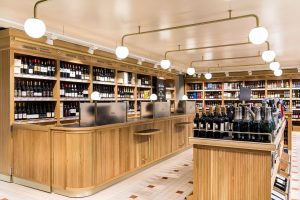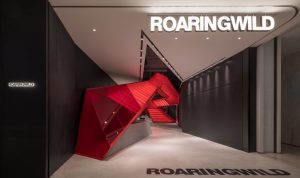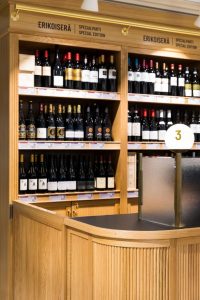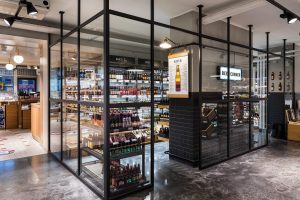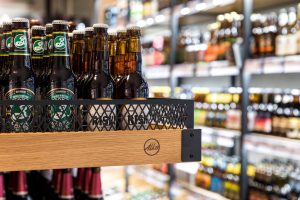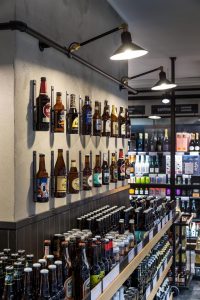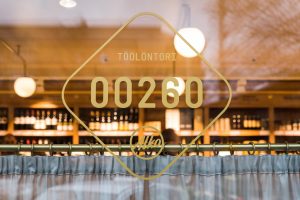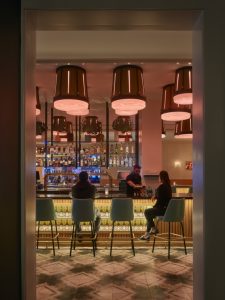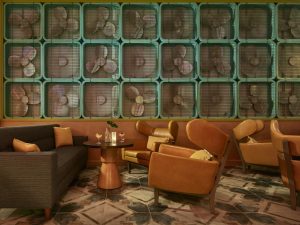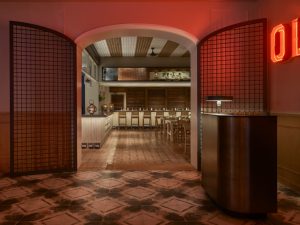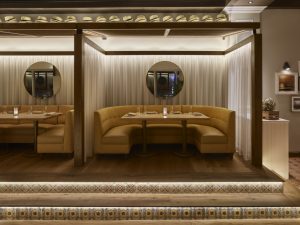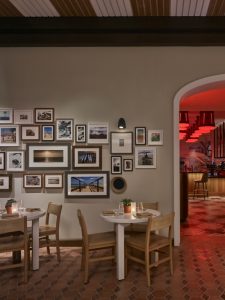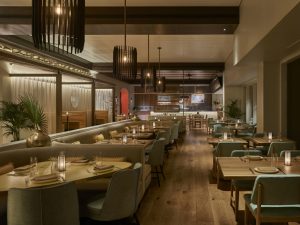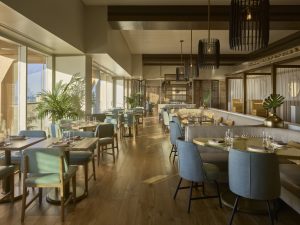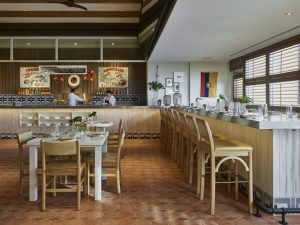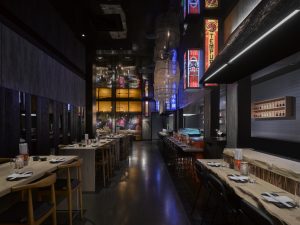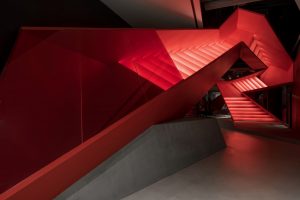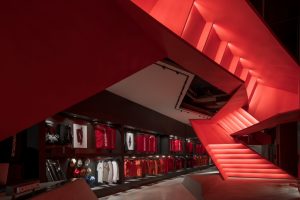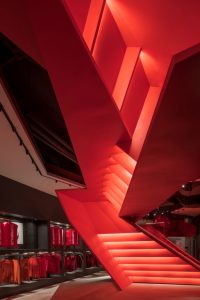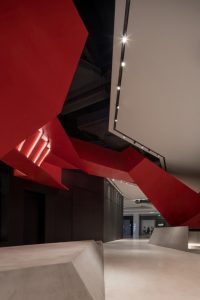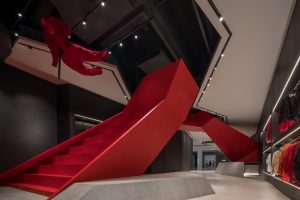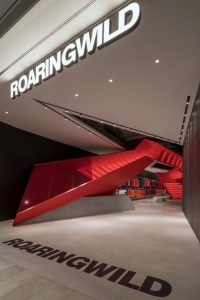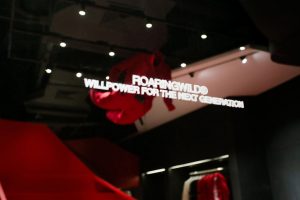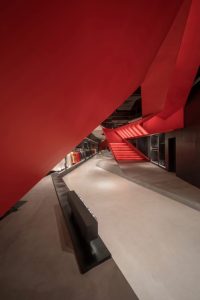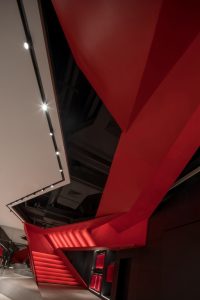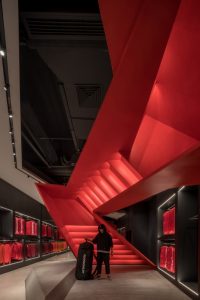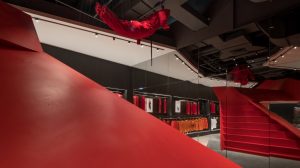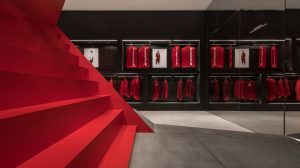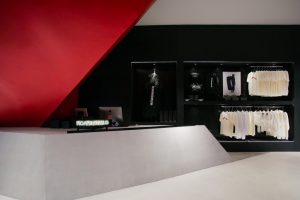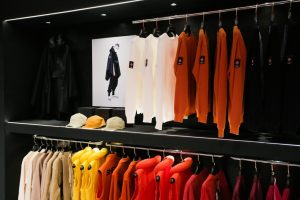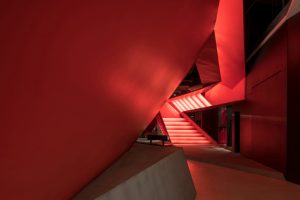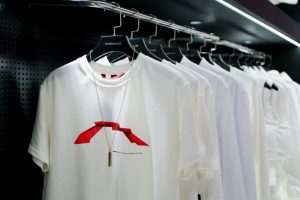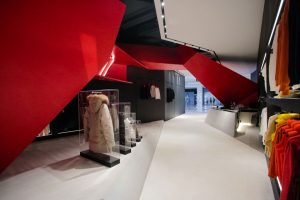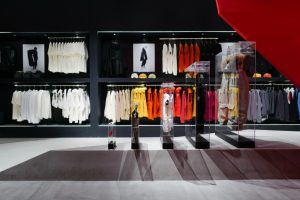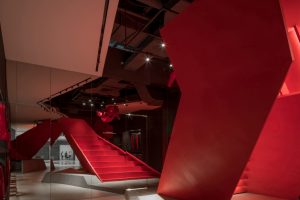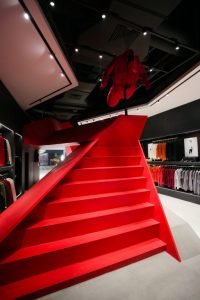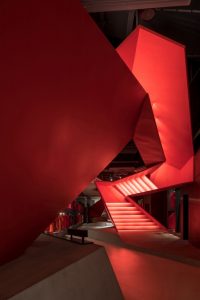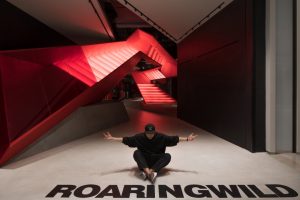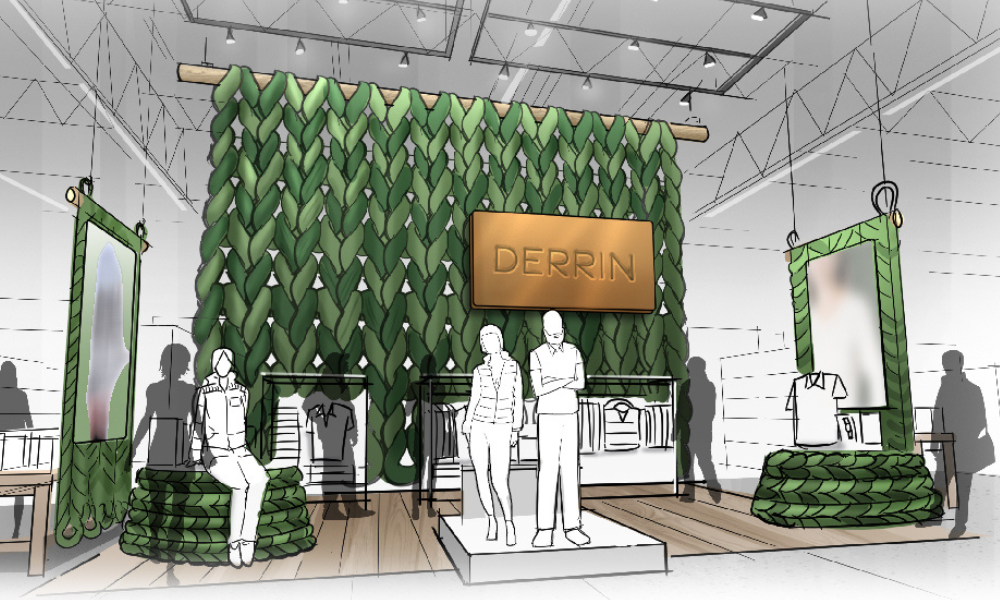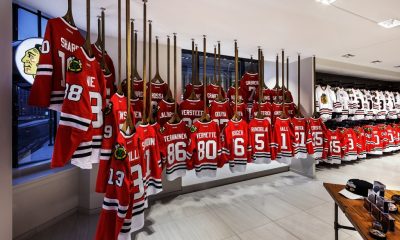
Roaringwild designed by Domani. Photography: Shaon Liu, China
Lighting is one of the most important elements of the in-store experience due to its innate ability to influence customers’ moods, alertness and attention levels. A current popular trend is the use of tunable (or “dynamic”) light, according to Sean O’Connor, Principal, Sean O’Connor Lighting (Culver City, Calif.), “I use the term ‘dynamic white’ as the environments are constantly changing,” he says. “For restaurants and cafés, dynamic white allows you to go from daytime looks with cooler color temperatures … to evening or late-night looks with warmer colors.”
This year, other trends from 2017 remain relevant, including the creation of mixed-use/after-hours spaces in high-end retail environments, supported by decorative lighting; the improvements of LEDs and dimming capabilities; and the goal of eliminating dreaded flicker.
Beyond the manufacturing trends, however, designers are continually recognizing the importance of lighting at retail, whether for decorative or vital reasons, like illuminating product, and are using these new advancements to their advantage.
“When the purchasing environment becomes more and more digital, the role of the physical location is to provide the visitor something extra they can’t get online,” says Juha Koskinen, Interior Architect and Lead Designer, Kuudes (Helsinki). “Lighting has the most significant role in conveying the desired shopping experience, so designers are paying attention to this more than ever.”
Advertisement

Alko designed by Kuudes. Photography: Paavo Lehtonen Photography
DRINKS ON ME
Finland’s national alcoholic beverage retailing monopoly, Alko (Helsinki), recently debuted a nostalgia-themed concept store for its 85th anniversary in the neighborhood of Töölö in Helsinki. Divided into two distinct sections, the front-of-house features a ’30s-inspired style, equipped with a retro service counter, while the back end portrays a modern look.
When it came to lighting, the design team at Kuudes focused on sourcing fixtures that complemented the first space’s vintage feel, opting for custom-made pendants. “The wattage was adjusted to a low level,” says Koskinen. “In addition to these pendants, modern spotlights create targeted illumination. The fixtures were arranged [symmetrically], creating an interesting contrast between modern and classic.”
The service counter was designed based on the team’s interpretation of reference photographs provided by Alko of its first locations. Designers also rebuilt the ceiling to hide any electronics or machinery that didn’t meld with the ’30s concept. The lighting works to tie all of these elements together by providing a familiar, pleasant ambience.
“Having the right kind of store lighting is one of the most important factors in this experience,” says Koskinen. “Targeted lighting brings out the products in a delicious manner and emphasizes the chosen details. The uneven distribution of light makes the space interesting, warm and cozy.”
Advertisement

Roaringwild designed by Domani. Photography: Shaon Liu, China
STAIRWAY TO…?
Situated in the Uniwalk shopping center in Shenzhen, China, the online brand Roaringwild (Shenzhen, China) recently unveiled its first offline experience for its “VIP customers,” according to Kingson Liang, Design Director of Domani (Guangzhou, China), the firm charged with the design. The team worked to create a breathtaking environment suitable for the brand’s 35-and-under “streetwear” demographic.
Its central illuminated statement piece is an R-shaped red staircase, a reference to the “R” in Roaringwild. Creating an M.C. Escher-type illusion, the individually lit stairs add a sense of depth and reality. “This is a brand based on street culture,” says Liang, “so this design [had] a very personalized proposal … which broke the traditional sales model.”
Various track and embedded spotlights were used throughout, along with directly lit apparel, to create high drama. “By contrasting the light and darkness of the space, it not only enhances attention, but helps … highlight the product color, materials, glossiness and other details,” says Liang. “Different from the traditional ‘bright space atmosphere,’ it highlights products with partial light in a relatively dark space, attracting customers to [come] in and explore.”
Advertisement
Designers had to pay careful attention to all aspects to attract the same attention offline as they have online.
“The trend in retail space lighting is combining science and comfort, considering whether the light effects and quantity can effectively match the function of the retail space and appropriately shaping the brand’s form,” Liang concludes.

Olón designed by dash design. Photography: Frank Oudeman, New York
CULINARY CONGA
When celebrity Iron Chef Jose Garces decided to open two new restaurants inside the Tropicana Atlantic City casino – one celebrating an Ecuadorian beach/nightlife theme and another highlighting Japanese culinary delights – he turned to dash design (New York) to implement his vision.
Located in a city where customers are already inundated with nonstop lights and sounds, the design team was challenged to create an environment that would draw customers in, while avoiding sensory overload.
According to Kristin Cullen, Lead Designer, dash design, the bongo-style fixtures above the bar in the Ecuadorian Olón restaurant did just that. “During the day, the lights are warm white; they become pinker around sunset and transition to red light at night. It really catches your eye from a distance throughout the casino floor.” This paired with a small stage for live bands attracts customers into the space.
David Ashen, Founder and Partner, dash design, explains that this color-changing trend continues to grow due to advancements in LEDs and the ability to more easily control dimming and CRI output.
Other elements throughout the space work to support the intended vibe, such as wall sconces and fixtures in one of the main dining areas that illuminate various pieces of Ecuador-inspired art and provide plenty of visual texture. Other unique design elements include Panama hats (made in Ecuador) decorating the dining area and a wall of box fans, reminiscent of a balmy summer scene.

Okatshe designed by dash design. Photography: Frank Oudeman, New York
Okatshe, Garces’ second restaurant, was located in a windowless area of the casino. “It’s in the background of the space, and we had to think of something clever to draw people into there,” says Ashen. “The pivotal thing was the bar; it’s super visible from the casino.”
Once inside Okatshe, the lighting truly drives the experience, providing the feeling of a Japanese alleyway, filled with illuminated street signs and fake storefronts.
With a stretched mylar ceiling and polished concrete floor, the space’s bright signage reflects light from top to bottom, creating a surreal atmosphere. “We found a photograph of a streetscape in Japan after it rained,” says Molly Lawenda, Lead Project Manager/Architectural Designer, dash design, explaining the inspiration behind the space’s reflectivity.

Alko designed by Kuudes. Photography: Paavo Lehtonen Photography
STEP INTO THE LIGHT
With lighting trends constantly evolving, it’s important to consider that some elements do tend to date the interior, according to O’Connor. “Decorative lights timestamp stores, so choose carefully when decorative lighting is required,” he says. “Design for longevity – you want customers today, tomorrow and five years from now.”
Above all, according to O’Connor, it’s important to consider how light affects the customer experience, which should come before following any of the latest trends. “Lighting can have a huge voice, even though it’s a supporting character to the product, and the store design, playing the leads,” he says. “Lighting isn’t just for product anymore, it’s also for people. How does the store make you feel?”
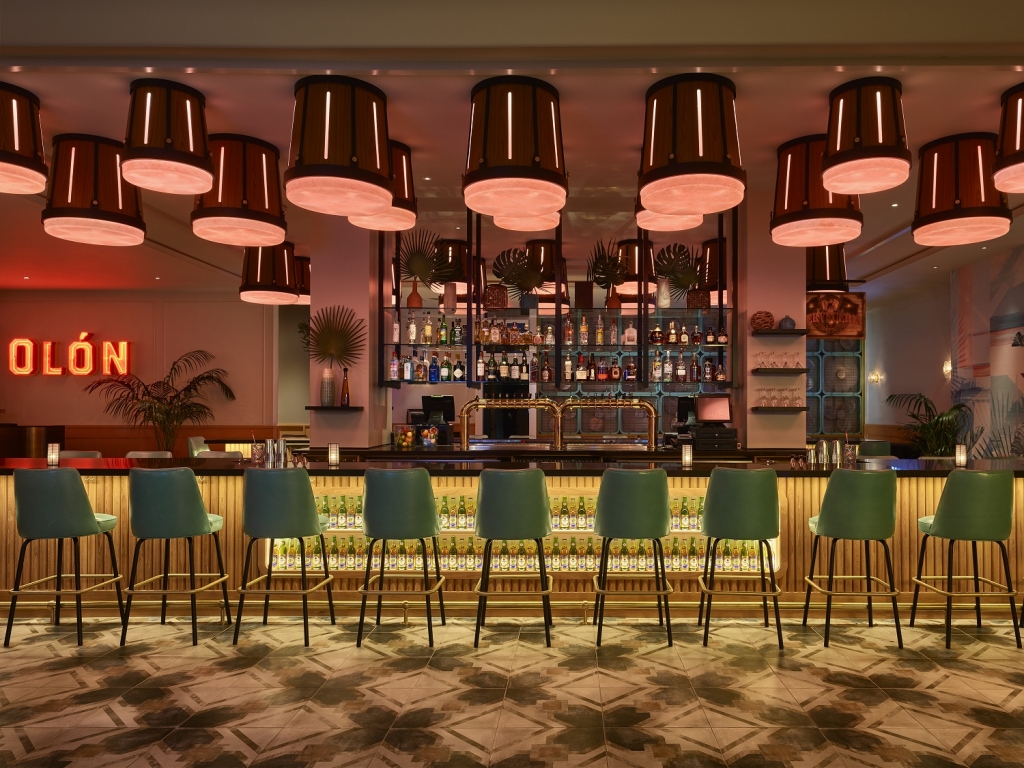

 Photo Gallery1 week ago
Photo Gallery1 week ago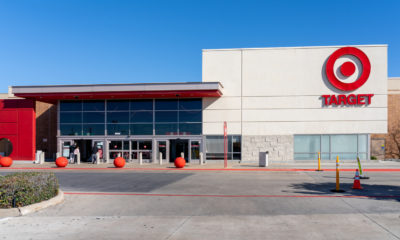
 Headlines2 days ago
Headlines2 days ago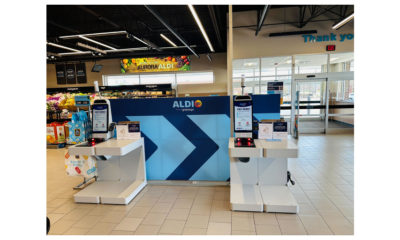
 Headlines1 week ago
Headlines1 week ago
 Headlines1 week ago
Headlines1 week ago
 Designer Dozen2 weeks ago
Designer Dozen2 weeks ago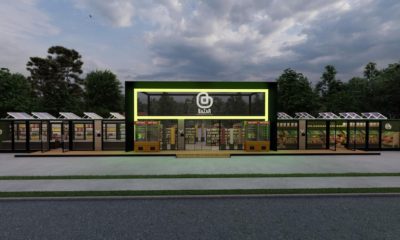
 Headlines1 week ago
Headlines1 week ago
 Designer Dozen6 days ago
Designer Dozen6 days ago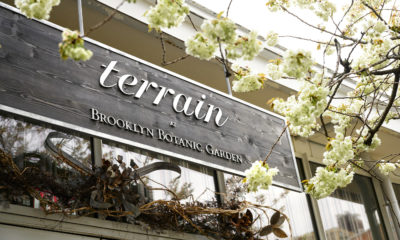
 Headlines1 week ago
Headlines1 week ago







